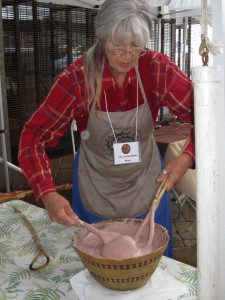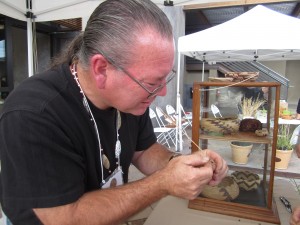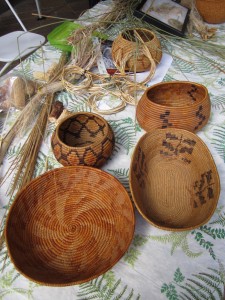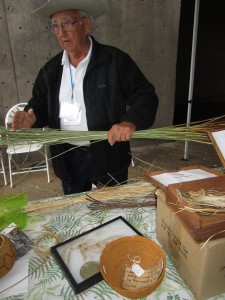THE FIRST IN A SERIES OF WONDERFUL WORKSHOPS PRESENTED BY THE CALIFORNIA INDIAN BASKETWEAVERS ASSOCIATION.
Over the last two centuries of California history, Indian basket weavers have had to struggle to maintain or reconstruct a cultural heritage that was nearly annihilated by Spanish mission culture, white settlers, and U.S. government policy. This past October at Santa Rosa’s Pepperwood Preserve, in the first in a series of interactive programs, master weavers of the California Indian Basketweavers Association (CIBA) demonstrated their success in not only carrying on their respective basket weaving traditions, but communicating to a mostly non-native audience just how central basketry, and its related skill of land stewardship, was to their cultures.
Using ethnobotanist M. Kat Anderson’s ground-breaking book, Tending the Wild, as a jumping-off point, weavers from across the state explained how maintaining the health of the forests and stream beds from which they harvested their basketry plants was key to their religious beliefs, cultural practices, and livelihood. Their stories provided context for Ms. Anderson’s premise that: “wherever…people made baskets, they tended the wild…weavers also introduced stewardship techniques. Because basketry materials have to be uniform, with little or no imperfections, they come from perennial plants that need to be managed.”
In five moving and emotional presentations by master weavers representing the Pomo/Wappo, Maidu, Karuk, Mono, and Ipai traditions, CIBA members gave personal accounts of how, with some few exceptions, their families were effected by historic anti-Indian policies that made cultural survival nearly impossible. For instance, Ipai (Mission) elder and retired engineer Justin Farmer, described how his grandmother , born in 1862, was taken from her parents as a baby and indentured to a white family to be a servant until age 16, with the result that she not only lost her native heritage, but also adopted the anti-Indian racism of her captors. When Mr. Farmer became interested in basketry some 40-50 years ago, he found only 4 surviving weavers –3 of them cousins—in all of southern California. With difficulty, he convinced one woman to teach him what had been traditionally a female skill, which first involved the gathering, sizing, and splitting of materials, primarily sumac, juncus grass, and deer grass (muhlenbergia). As a result of assiduously collecting and studying Indian baskets over a lifetime, Mr. Farmer has now published five books on southern Indian basketry, and has been able to demonstrate basketry to 100’s of weavers, native and non-native. (For many years he taught at the biennial San Diego-based Misti Washington basketry conference)
Lois Conner Bohna’s Mono relatives in central California suffered similar deprivations. While her grandmother managed to avoid the Indian boarding school that her siblings were forcibly sent to, she did so only by hiding her “Indianness” . Fortunately, Ms . Conner Bohna was able to learn from her mother’s first cousin, and has baskets—including the one she used to make us acorn porridge—from her grandmother’s generation. With a deer grass base that makes the basket watertight (it expands when wet!), and sedge root construction with bracken fern ornamentation, Lois explained how baskets like hers “like to work”—the materials are better preserved through use.

Lois Conner Bohna cooking acorn porridge in her grandmother’s basket
But plants such as sedges, willows, and juncus grass, essential to Indian basketry, are becoming less accessible as land which historically was maintained by families of basketweavers has either fallen into private hands and been fenced off, or acquired by government entities (Caltrans, U.S. Forest Service) who have applied insecticides to stream beds and roadside plant populations.

Clint McKay demonstrates how sedge is split and sized.
Speaker Susan Campbell, a Maidu /Pit River/Washoe weaver from Red Bluff who relies on red willow for basketry, has opposed the Caltrans policy of spraying willow, rather than using natural methods, to combat a moth infestation; two of her friends were poisoned while splitting willow, which is traditionally done by mouth.
Clint McKay, a Pomo/Wappo/Wintun master weaver and CIBA Board Chairman, was the sole speaker blessed by being raised in an intact and unbroken traditional culture, surrounded by baskets, at the Dry Creek Rancheria. Among his teachers were Laura Somersal the legendary Mabel McKay, whose baskets are known to almost anyone familiar with California basketry

Basket materials & baskets made by Mr. McKay and his family
He tells us that one of the very worst things you can do is to call Indian basketry an “art form”; “It is the very essence of our lives. We came into the world in a basket…we gather our food, store it, cook it, and eat out of a basket. “ Dance regalia worn at ceremonies is attached by baskets, and as one dance song proclaims, “we are people of the basket.”
M. Kat Anderson, whose book describes California Indian plant maintenance policies, including controlled burns, spoke only briefly at the conference, choosing to yield her time so that participants could see for themselves how skilled and arduous the hands-on processing of basketry materials was during the “Walkabout” part of the program. However, she explained that when she was doing her doctoral studies in forestry and ecology, no one had yet studied how native peoples managed the environment. She thanked her mentors, which included CIBA speakers Lois Connor Bohna and Justin Farmer, and noted that there would not have been a book if there were no elders who shared their knowledge with her; “that legacy is the benchmark of the past to which we want to aspire.”

Justin Farmer discusses the juncus grass used in Ipai baskets.
Through her research Ms. Anderson has concluded that what she calls Indigenous Stewardship Methods: “are based upon the notion of cyclical harvest & regeneration & sustainability; the idea of leaving the plant in place for multiple harvest over many generations. Traditional stewardship of wildlands with coppicing, pruning, or burning may enhance wildlife habitat and increase biodiversity.”
After conference participants heard short presentations with enticing titles like “Secrets of the Woodwardia Fern” ,“Bracken Fern Preparation and Use,” and “Working with Willow”, and watched short videos focusing on the identification and gathering of basketry plants & basketry tradition, we feasted on acorn porridge that Lois Conner Bohna prepared for us in traditional fashion, heating the acorn meal and water in her grandmother’s basket by submerging hot fireplace rocks . Then, during the afternoon “Walkabout” to learning stations maintained by the speakers, we were given the opportunity to observe and try our hand at the processing of basketry materials – sedge root, willow, juncus, redbud, and woodwardia ferns—and to personally experience the difficulty of preparatory skills!
You don’t have to be a basket weaver to be enthralled and moved by the lore and learning of the presentations & demonstrations, and the beauty of the historic and contemporary baskets on display. Look for a schedule of future “Tending the Wild” Workshops on the CIBA website.
Resources:
CIBA website: www.ciba.org
The following is from CIBA’s statement of History and Vision: “ CIBA was founded in the early ‘90’s and has grown to nearly 1000 members statewide provid[ing] opportunities for Indian weavers to convene, learn, exchange information and showcase their work. CIBA also collaborates with local, state, and federal agencies to increase basket weaver’s access to traditional gathering areas, reintroduce Native basketry plants to the natural environment & to limit the use of harmful pesticides.”